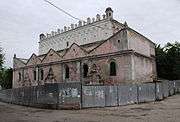Zhovkva
Zhovkva (Ukrainian: Жовква [ˈʒɔu̯kwɐ]; Polish: Żółkiew; Yiddish: זאָלקוואַ, romanized: Zolkva; Russian: Жо́лква, 1951–1992: Нестеров Nesterov) is a city in Lviv Oblast (region) of western Ukraine. It is the administrative center of Zhovkva Raion (district). Its population is approximately 13,834 (2017 est.)[1].
Zhovkva Жовква Żółkiew | |
|---|---|
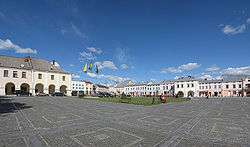 Zhovkva main market square | |
 Flag 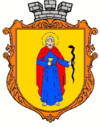 Coat of arms | |
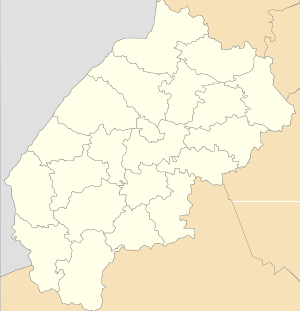 Zhovkva Zhovkva location on a map  Zhovkva Zhovkva (Ukraine) | |
| Coordinates: 50°4′0″N 23°58′0″E | |
| Country | |
| Oblast | |
| Raion | Zhovkva Raion |
| Founded | 1597 |
| Town rights | 1603 |
| Area | |
| • Total | 7.64 km2 (2.95 sq mi) |
| Population (2013) | |
| • Total | 13,594 |
| • Density | 1,742/km2 (4,510/sq mi) |
| Postal code | 80300—80304 |
| Area code(s) | +380 3252 |
| Sister cities | Kraśnik, Poland |
History
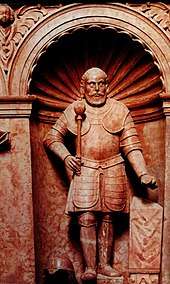
A village named Winniki was mentioned at the site in 1368 and was part of the Kingdom of Poland under the Piast dynasty.[2] The town was founded in 1597 as a private fortified town and named Żółkiew after its founder, one of the most accomplished military commanders in Polish history, hetman Stanisław Żółkiewski. Like Zamość, which was founded by Żółkiewski's mentor Jan Zamoyski, Żółkiew was built on an ideal Renaissance city plan. Due to its strategic location at the intersection of important trade routes, the town prospered.[3] In 1603 it was granted town rights by King Sigismund III Vasa.[2][4] From its earliest days, the population was a mix of Poles, Armenians, Ukrainians and Jews, with several great Jewish scholars basing themselves out of Zhovkva, such as Betzalel HaLevi of Zhovkva.
In the 17th century, it became the royal residence for King John III Sobieski of Poland, and a hub of religious life, arts and commerce.[3] In 1676, King of France, Louis XIV, visited Żółkiew and awarded the Polish King with the Order of the Holy Spirit.[4] The city was the site of celebrations after the victorious Battle of Vienna of 1683, and in 1684 the Polish King was awarded there with papal gifts, sent by Pope Innocent XI.[4]
As a private town of Poland, Żółkiew was the property of the Żółkiewski, Daniłowicz, Sobieski and Radziwiłł families.[2][4] During this period, most of the city's landmarks were built, including the Zhovkva Castle and St. Lawrence's Church, both founded by Stanisław Żółkiewski, the Dominican church, founded by Teofila Sobieska, a fortress-like synagogue, co-financed by King John III Sobieski, and the foundations of the king's sons: the Saint Lazarus church founded by prince James Louis Sobieski and the Holy Trinity Church, founded by prince Konstanty Władysław Sobieski.[3]
Late modern era
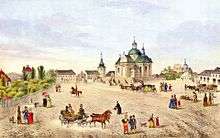
From the First Partition of Poland in 1772 until 1918, the town (named Żółkiew) was part of the Austrian monarchy (Austrian part of Austro-Hungary after the compromise of 1867), head of the district with the same name, one of the 78 Bezirkshauptmannschaften in Austrian Galicia province (Crown land) in 1900.[5]
The West Ukrainian People's Republic, established on November 1, 1918, included the whole Zhovkva povit (county).[6] The town came under Polish control in May 1919, seven months after the re-establishment of independent Poland, confirmed by the Paris Peace Conference in June 1919 and the Peace of Riga in 1921. It was a county (powiat) seat located in the Lwów Voivodeship. In the interwar period the 6th Cavalry Regiment of the Polish Army, named after hetman Stanisław Żółkiewski, was stationed in the town.
World War II and recent times
In 1939, following the Soviet invasion of Poland, Żółkiew, together with the rest of Poland's Kresy Wschodnie, was occupied by the Soviet Union.[2] The Soviets destroyed the statue of King John III Sobieski, located in front of the town hall and the statue of the city founder hetman Stanisław Żółkiewski, located in the park. In June 1941, the Soviets executed 34 people, Ukrainians and Poles, in a prison organized in the former Żółkiewski castle, as part of the NKVD prisoner massacres.[4] A few people managed to escape the massacre, including a German prisoner of war.[4]
From 1941 to 1944 Zhovkva was occupied by Germany.[2] At the beginning of the occupation, Jews numbered around 4500 and were almost half the town's population. Less than 100 Jews survived the Holocaust. In 1942, Germans, assisted by Ukrainian police, deported 3,200 Jews to the Belzec extermination camp.[2] Many others were killed by Germans, assisted by Ukrainian police, in the vicinity of the city, and the rest were taken to the Janowska concentration camp.[2] [7]The synagogue was blown up by the Nazis in 1941, leaving only the outside walls. In 2000, the building was declared one of the world's most endangered sites by the World Monuments Fund.[3] A restoration campaign began in 2001, supported by WMF's Jewish Heritage Program and other sources, which is ongoing.
From July 1944 it was occupied by the Soviets again and in 1945 it was annexed by the Soviet Union. It became a part of Ukrainian Soviet Socialist Republic in 1944. As a result of the actions of both the Ukrainian nationalists of the UPA and the Soviets, almost all Poles left the city in 1944–1946.[8] In 1951 the town was renamed Nesterov after the World War I aviator Pyotr Nesterov who became the first to perform aerial ramming in the history of aviation near Zhovkva in 1914. The name Zhovkva, which is the Ukrainian version of the historic Polish name, was restored in 1992, after Ukraine became independent of the Soviet Union.
Historical sites
The Collegiate Church of St. Lawrence, a domed church from the 17th century founded by Stanisław Żółkiewski and built by a group of Italian architects, was turned into a warehouse under Soviet rule. After Ukraine declared independence in the early 1990s, the church was restored.[3] The church contains the sarcophagus of the city's founder Stanisław Żółkiewski.
The town center of Zhovkva was declared a heritage site in 1994, and restoration work is now under way.[3] Zhovkva Castle, the town's oldest and largest building, former residence of hetman Stanisław Żółkiewski and King John III Sobieski, is being converted into a culture and conference hall.[3]
The wooden Holy Trinity Church built in 1720 by Polish prince Konstanty Władysław Sobieski, was listed in 2013 as a World Heritage Site by UNESCO, as a part of the composite site Wooden tserkvas of the Carpathian region in Poland and Ukraine.
Relics of Saint Parthenius, 3rd-century Christian martyr from Rome were moved to Zhovkva in 1784. They are kept at the local Church of Holy Heart of Jesus, run by Ukrainian Greek-Catholic monks of the Basilian order.
A Renaissance architecture fortified synagogue, built between 1692 and 1698, and co-financed by Polish King John III Sobieski, is located in the town.
Gas-free city
In 2017 Zhovkva became the first city of Ukraine that did not use gas in central heating system.
European Union financed Zhovkva project. It allowed to fully eliminate gas and use wood instead.
Notable residents
- Aaron Margalita, Jewish scholar who converted to Christianity
- Aaron Selig ben Moses of Zolkiev, Jewish scholar
- Aaron of Trebowla, Jewish scholar
- Ivan Rutkovych, Ukrainian iconographer
- Ivan Krypiakevych, Ukrainian historian, academician
- Zbigniew Burzyński, Polish balloonist and constructor of balloons, pioneer of Polish balloons
- Clara Kramer, Holocaust survivor
- Salcia Landmann, researcher of Yiddish culture
- Jakub Ludwik Sobieski, Polish prince, son of King John III Sobieski
- Jakub Sobieski, Polish parliamentarian, military leader and father of King John III Sobieski
- Włodzimierz Puchalski, Polish photographer and film director
- Stanisław Żółkiewski, Polish nobleman and military commander, founder of the town
- Włodzimierz Stożek, Polish mathematician of the Lwów School of Mathematics
- Hillel ben Naphtali Zevi, Lithuanian rabbi
- Nachman Krochmal, Jewish philosopher
- Jacob ben Wolf Kranz, maggid
- Zalman Schachter-Shalomi, one of the founders of the Jewish Renewal movement and an innovator in ecumenical dialogue
- Hersch Lauterpacht, member of the United Nations' International Law Commission
- Lubomyr Romankiw, Ukrainian computer scientists
See also
References
- "Чисельність наявного населення України (Actual population of Ukraine)" (in Ukrainian). State Statistics Service of Ukraine. Retrieved 26 August 2017.
- "Żółkiew". Encyklopedia PWN (in Polish). Retrieved 11 October 2019.
- Ruth Ellen Gruber. "For a fortress town, a second renaissance." January 12, 2009. The New York Times. Retrieved 2013-03-29.
- "Żółkiew okiem historii". MagiczneRoztocze.pl (in Polish). Retrieved 11 October 2019.
- Die postalischen Abstempelungen auf den österreichischen Postwertzeichen-Ausgaben 1867, 1883 und 1890, Wilhelm KLEIN, 1967
- (in Ukrainian) Лев Шанківський. Стрий і Стрийщина у визвольній війні 1918–1920 рр.
- Megargee, Geoffrey (2012). Encyclopedia of Camps and Ghettos. Bloomington, Indiana: University of Indiana Press. p. Volume II, 852-3. ISBN 978-0-253-35599-7.
- Magda Osip-Pokrywka, Mirek Osip-Pokrywka, Polskie ślady na Ukrainie, Wydawnictwo BOSZ, 2013, p. 175
External links
| Wikimedia Commons has media related to Zhovkva. |
- (in Polish) Żółkiew (Zhovkva) in the Geographical Dictionary of the Kingdom of Poland (1895)
- castles.com.ua - Zhovkva
- ua.vlasenko.net - Pictures of Zhovkva
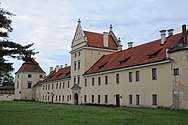
.jpg)
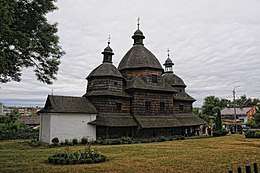
.jpg)
